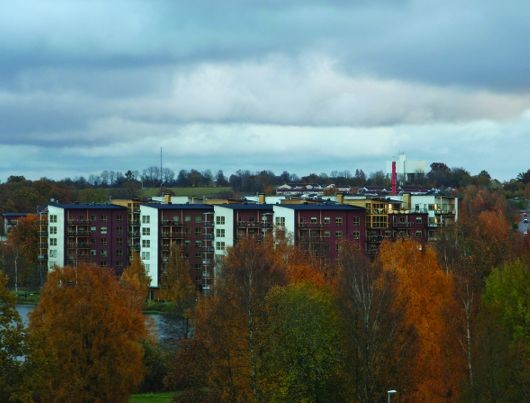
Växjö combined heat and power plant at Sandviken. Photo provided by the Municipality of Växjö
- We have to go back to the 1970s during the first oil-crisis, when fossil-fuels rocketed in price. In Växjö this led to some key decisions being made, and primarily that the municipality should build a combined heat and power plant based on surpluses, or leftovers, from the forest-industries; tree-tops, branches, bark, sawdust etc. We thought, why not use it as a source of heat rather than just leave it to rot, explains Sarah Nilsson.
Ms. Nilsson is the head of strategic planning in the municipality and has closely followed environmental developments within the municipality for many years.
- Economically it was not very profitable at the start, but we stuck with it nonetheless. The second half of the 1980s saw low electricity-prices in Sweden, the result, in part, of the significant investment made in nuclear power. However a turning-point came in 1991 when the Swedish government introduced the concept of CO2-taxation. Thereafter we were in a position to really compete with the more traditional oil-burners. We could provide both cheaper and cleaner energy.
The city is relatively flat and tubes with warm water for district-heating have now, more or less, been laid everywhere within the central areas. The operation is run through the municipality-owned Växjö Energi AB. At present the company delivers 30% of all the electricity consumed in the city and 100 % of all district-heating used. Some 92% of all heating in the municipality is based on renewable sources.
The ordinary consumer pays 55 öre per kWh for heating, a price that is substantially lower than other alternatives on the open market. For electricity the rates are similar to those of its competitors. The company is currently profitable and doing quite well.
Växjö has continued to expand local heat and power production. New plants have been built and older ones made more efficient. The increase in the popularity of solar-energy production and the drive for better insulated buildings have also been added to the positive outlook in terms of the heating-and energy equation. Several lakes have been cleaned and there are now ample opportunities to go for a swim within the city.
Click at the figure to see full size.
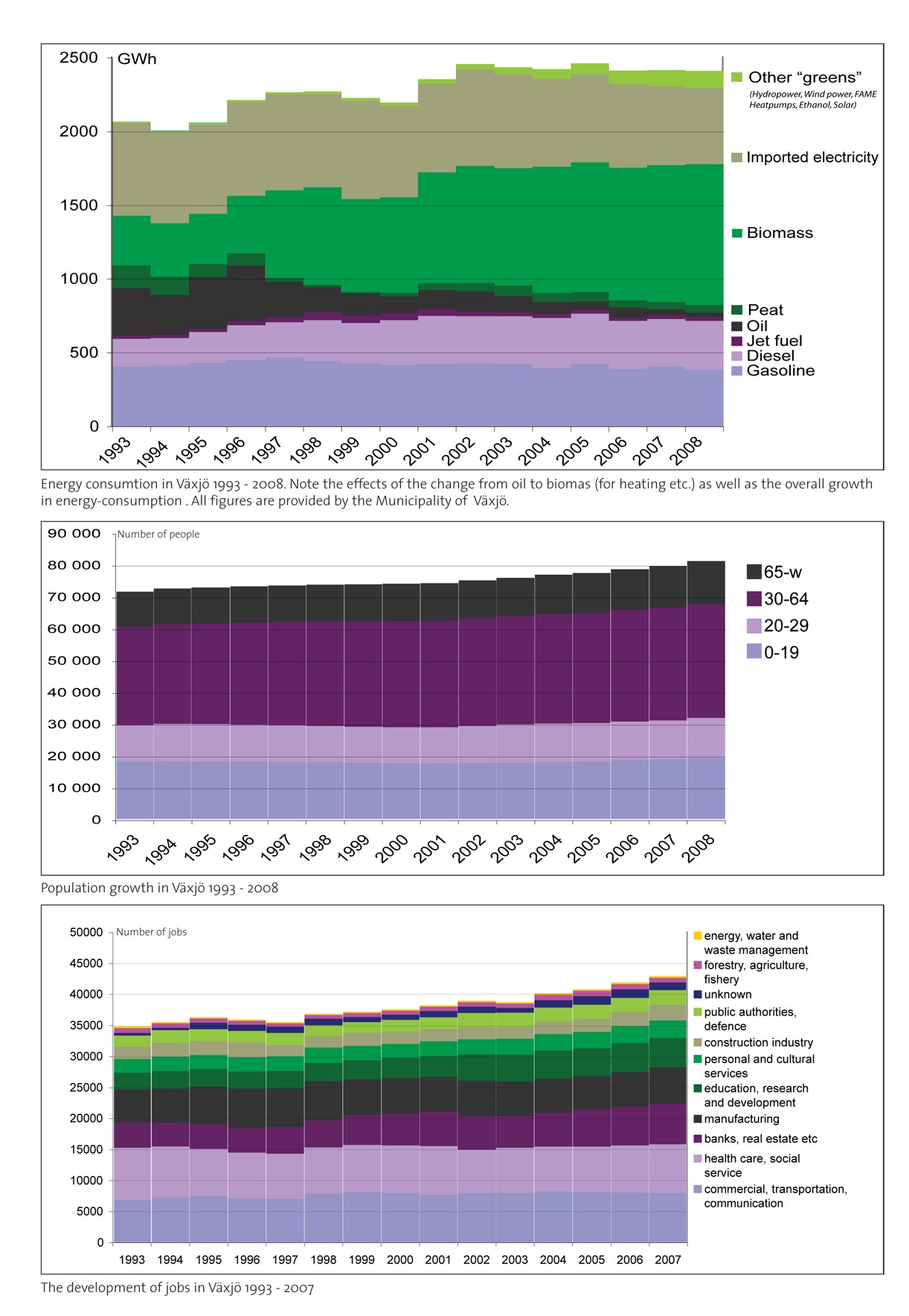 The outcome of these efforts has been that the city has seen a reduction of no less than 84% in CO2 emissions from heating – mostly of buildings. Including transport and all other energy-consuming activities these CO2-reductions are measured at an impressive average of 35% - per inhabitant. In both cases here we are talking about the period 1993-2008.
The outcome of these efforts has been that the city has seen a reduction of no less than 84% in CO2 emissions from heating – mostly of buildings. Including transport and all other energy-consuming activities these CO2-reductions are measured at an impressive average of 35% - per inhabitant. In both cases here we are talking about the period 1993-2008.
Emissions from kerosine (jet fuel) sold at the local airport are included. Emissions generated from flights by Växjö-citizens from other airports are not. On the other hand, Växjö-airport is used by the whole region and has 160 000 passengers annually.
The city has grown by some 10 000 inhabitants or close to 15% since 1993. The majority of this increase is however students at the constantly expanding Växjö University. At present there are more than 16 000 of them and in fact more than 3 000 live on the University campus located just outside the city-centre. Few students have cars but many have bicycles. The city claims that 46% of all households in the municipality (including students) do not own a car.
- Your statistics show that for the transport-sector there has been an increase of 10% in emissions from 1993 to 2008?
- This is measured per capita. The explanation is primarily that people have become richer, have more cars and drive more. It is really the transport-sector that is our unsolved problem. In Malmö for example all buses now run on locally produced bio-fuel but here they are still running on fossil fuels underlines Sarah Nilsson.
- We manage however to produce enough bio-fuel (bio-gas) for some fifty private and municipality-owned vehicles. In addition, there are another fifty private car-owners really interested in joining the scheme. And we have plans to expand, adds the city's strategic planner.
In the official brochure Fossil Fuel Free Växjö the municipality's energy-goals are spelt out thus:
• To reduce fossil carbon dioxide emissions per inhabitant by at least 50% by 2010 and by 70% by 2025, as compared to 1993.
• To reduce the consumption of electrical energy by at least 20% per inhabitant by the year 2015 compared to 1993
• To increase cycle traffic by 20% by 2015 as compared to 2004
• To increase the use of public transport by at least 20% in the city and 12% in the region by 2015, as compared to 2002
• To end the municipality's use of oil for heating, other than for complementary use, by 2010
• To reduce fossil carbon dioxide emissions from the municipality's transport services by a minimum of 30% by 2025 compared to 1999.
"In Växjö we do business the Småland way (...) We know how to make plenty out of what looks like nothing", boasts the municipality in a brochure on the region's entrepreneurial spirit. The city has 7600 companies and 82 000 inhabitants.
- One example of this could be that most of the ash end product from the power/heat plants is returned to the woods as fertilizer. However, we have not started to burn the roots yet, so the potential to expand remains, comments the planner Sarah Nilsson.
- What spurred this greening of Växjö?
- Mostly the initiatives have come from civil servants rather than from politicians. However, I should mention that there is no major political disagreement within the municipal council on this subject. All parties are in favour. I also think this will continue as long as the green sprit creates jobs and incomes as well as fame for Växjö.
Växjö has received several international prizes in relation to its effort to generate a better climate. Each year the city has more than 600 official visitors who come to learn from their experiences. In fact the municipality has its own officer, Mr. Johan Thorsell, dealing with international relations.
- Of course we enjoy all this attention, but it takes quite a bit of time to do it properly. Therefore we are currently looking into the business-opportunities opened up by our efforts in this field. In-house we already call ourselves 'The European Climate Protection Valley', he explains.
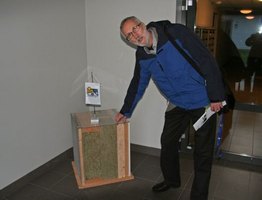


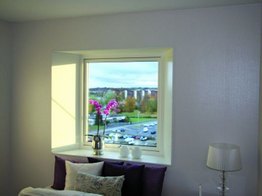
Part of the "greening" process in Växjö is the drive to build passive houses and large wooden structures. Top to left shows the record eight storey high wooden houses in Limnologen. Bottom left is Portvakten Söder built in 2008 combining high-rise wooden structures with the passive-standard. Outside clading is cement-fibre plates. Inside is gypsum.Window-photo to show thickness of finished wall. Top right Erik Hallonsten, Senior Manager of Hyresbostäder Växjö shows model illustrating the isulation-construction in the passive house. All photos: Odd Iglebaek
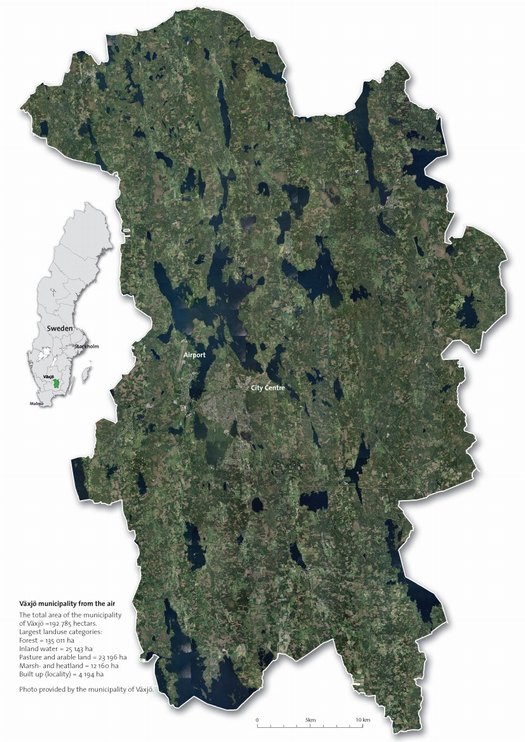
Växjö municipality from the air
The total area of the municipality of Växjö =192 785 hectars. Largest landuse categories: Forest = 135 011 ha Inland water = 25 143 ha Pasture and arable land = 23 196 ha Marsh- and heatland = 12 160 ha Built up (locality) = 4 194 ha Photo provided by the municipality of Växjö.
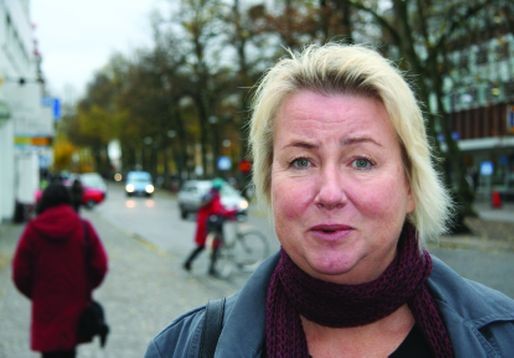
Sarah Nilsson, Head of Strategic Planning in Växjö. Photo: Odd Iglebaek
By Odd Iglebaek